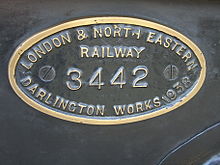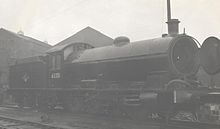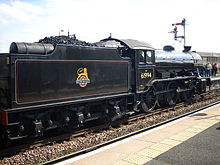- Darlington Works
-
Coordinates: 54°32′18″N 1°33′09″W / 54.5382°N 1.5526°W Darlington railway works, known in the town as North Road Shops, was built in 1863 by the Stockton and Darlington Railway in the town of Darlington in the north east of England.
Contents
NER History
The first new locomotive was built at the works in 1864. Though the railway had amalgamated with the North Eastern Railway (NER) in 1863, it continued to build its own designs for a number of years. In 1877 the first North Eastern designs appeared.
In 1914 a class of NER Bo+Bo electric locomotives were built at the works to run between Shildon and Newport. Ten of these 1500 volt direct current locomotives were completed.
Sir Vincent Raven designed the NER Class T2 0-8-0 freight locomotive in 1913, and by 1921 the works had built 120 of the engines, which were later designated Q6 by the LNER. The heavier and more powerful Raven NER Class T3 0-8-0 (LNER Q7) followed in 1919, 15 engines being completed by 1924.
LNER history
Under the LNER it continued to play a major role, producing a new engine each week, with Gresley's K3 class 2-6-0 appearing in 1924. Both the class V2 and A1 express locomotives were also built. By 1927 the works was the town's largest employer.
Darlington works built six LNER Class K4 2-6-0 locomotives in 1937/38 for operation on the West Highland Line. No. 3442 (later 61994) The Great Marquess has been preserved in full working order and in 2009 was still hauling special steam trains on the UK main line network.
Nationalisation
After nationalisation, Darlington built both steam and diesel locomotives, including BR standard class 2. The equivalent of the LNER Class E1 0-6-0 tank locomotive had been built, virtually unchanged since 1898. In 1954 during the modernisation of British Railways the works was enlarged, but in 1962 the BR Workshops Division was formed and, with the rationalisation the works was run down and closed in 1966.
Current use of the site
The site since about 1979/80, is occupied by the Morrisons supermarket, and the adjacent Bowls Hall, with the original clock which was restored, was re-erected by contractors Fairclough Building Ltd onto the east wall of the supermarket overhanging North Road.
References
- Larkin, E.J.; Larkin, J.G. (1988). The Railway Workshops of Great Britain 1823-1986. Macmillan Press.
Categories:- Railway workshops in Great Britain
- North Eastern Railway (UK)
- Darlington (borough)
Wikimedia Foundation. 2010.



